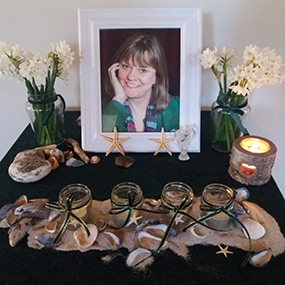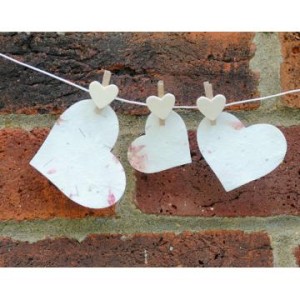“This is what happens around the world;
if you love, you grieve, and there are no exceptions.”
Funerals. They’re not something people like to think about, let alone talk about. They conjure up images from the movies of families huddled together by the graveside on a dark, grey, rainy day, sheltering under black umbrellas, as their loved one is laid to rest.
Or maybe your own experience of attending a funeral immediately comes to the surface of your consciousness. Saying goodbye to someone who held a special place in our heart isn’t something we would willingly choose. The greater the love, the greater the loss. Grief hurts.
If you’ve been involved in organising a funeral, you’ll probably have had a sense of the factory-farm nature of getting one lot of mourners into and out of a crematorium before the next lot of mourners arrive. There’s no time to be still. No time to let go. No real sense of having time and space to process what should be a meaningful and heart-felt ceremony. The same is often experienced in church services, too. You have an allotted time in which to be in and out. Does it have to be this way? No. Not at all. There are alternatives.
What can you do if you’re responsible for, or part of a family that is, organising a ceremony? Firstly, consider all the aspects of what it means to create a meaningful funeral.
The first step might well be to think outside the box. Do you have to use the church? Do you have to use the crematorium? I’m not saying or suggesting either of these venues is wrong, but do bear in mind that you will be placing yourself and other mourners under a severe time restriction. Regardless of your venue choice, you can still incorporate meaningful beliefs, whether they’re religious or otherwise.
For any ceremony, creating a sense of sacred space immediately brings the human spirit to awareness. We see and feel that something out of the ordinary from daily life is about to happen. Whether you’re acting in the capacity of a celebrant or as a loving family member, there is so much you can do to set up a ceremonial space. Firstly, consider the venue. What was important in the deceased’s life? Were they a member of a sporting group? For example, could you hire a yacht club, or football club or village pub? Maybe they were a keen gardener or potter? Is there a garden or pottery place where you could hold the ceremony, and possibly the reception? Maybe you’ll opt for a graveside burial, and then have a longer ceremony in their favourite café (outside business hours). What about your local village hall?
Maybe your loved one was passionate about the sea? Could your ceremony be on a quiet beach?
Perhaps there’s an old barn that could be used for the ceremony?
There are actually so many possible options for funeral venues that when you start thinking about them, you’ll wonder why people tend to go down the two routes of church/cemetery or crem. You will need permission, of course, from the land/building/venue owner. Legally, your only requirement for the ceremony is that the deceased’s body is covered. You do not need a coffin. You can use a shroud.
The key for a mindful and meaningful ceremony is to choose a place where you will not feel rushed.
When considering how to set up the ceremonial space, think about all the human senses:
Sight: What decorations might you use? Flowers, plants, leaves, candles, lanterns. If you’re in Nature, let that be your décor.
Sound: Music, Nature (such as the wind or a babbling brook), bells, chimes, singing.
Taste: Maybe your loved one had a favourite drink? Could a small drinking vessel, such as a goblet, be passed around for everyone to share? (with a cloth napkin to wipe the rim after each person). Or you could use spring water…the foundation of all life. Maybe a small biscuit or chocolate could be part of the ceremony, as a way of honouring the sweetness of the deceased’s life?
Touch: Soft cloth for the altar, or a little memento for each person.
Smell: incense, essential oils, fresh air, scented flowers, or a sprig of rosemary on each seat for ‘remembrance’ which could then be placed on the shroud or coffin just before the committal.
To enhance your sacred space, consider how you might define the area. Perhaps near the altar (a small table with a photo, candle, flowers, and anything symbolic of meaning to the deceased), you could make a circle on the ground/floor using: leaves, berries, rosehips, acorns, pinecones, flowers, or things that might have held meaning, such as marine ropes, bailing twine, paintbrushes, Matchbox cars, dolls, etc.
Why not create a candlelit labyrinth using jam jars with a tealight in each one, inside a brown paper bag filled with sand. This is particularly beautiful if you’re having an evening ceremony. The coffin could be in the centre of the labyrinth, with each mourner taking the time to walk into the centre to say goodbye, and slowly going back out into the world as a different person. You can download a Classical Labyrinth pattern here: https://labyrinthsociety.org/make-a-labyrinth
Perhaps you could create a memory jar. Using a large glass jar, invite each mourner to write on a piece of card their favourite memory of the deceased.
Maybe you could decorate the space with Prayer flags/Love flags with colourful images or words relating to the deceased and their life.
Each mourner could cut out hands (drawing their hands onto cardboard, and then cutting them out) to put with coffin, and writing their names on saying ‘we are with you’.
What about wooden or paper heart confetti to sprinkle over coffin or shroud?
Print cards with the words “I’ll always remember when…” and leave a pen/pencil for each guest to add their memory.
Consider a Lantern Ceremony (glass jam jars with thin wire and tea light)…glass paints or coloured tissue paper glued on the outside. Mourners could gather in a circle around the coffin/shrouded body, and create a circle of love throughout the ceremony. You can just imagine, I am sure, how powerful such a circle would feel.
Use the deceased’s favourite colours as a theme.
Why not have a long piece of white wallpaper, and leave crayons or felt pens for mourners to create a timeline of the deceased’s life: they write down when and where they met.
This isn’t necessary, but you might find it inspiring: Consider ‘funeral favours’ for the mourners.
On each mourner’s seat, leave a bookmark of the deceased, plus their favourite quote.
Wildflower seeds. You can print your loved one’s name, dates of birth and death, and words of choice such as ‘forget me not’.
http://www.growamemory.co.uk/Wildflower-Seed-Packet-Memorial-Gifts/
Flower bulbs. Give each mourner a bulb or bulbs to plant in memory of your loved one.
What about leaving a copy of your loved one’s favourite recipe printed out?
Depending on the location of your ceremony, you might consider a dove release, butterfly release or eco-friendly balloon release.
In the midst of your grief, allow yourself to channel the adrenalin into creative choices.
By choosing an independent celebrant, you are taking a huge step towards gifting your loved one with a life-centred funeral. This is your final gift to them.
“When words are inadequate, have a ritual.” ~ Anon
Veronika Robinson is an Independent Funeral Celebrant who is available to officiate life-centred ceremonies throughout Cumbria.
www.veronikarobinson.com/celebrant




















A friend of mine recently passed away, so I’ve been trying to help with ideas for the funeral. The family wants to celebrate his life, so I think these ideas will definitely come in handy. I like that you suggest thinking about the human senses like sight and sound for the funeral by including music and decorations.
This article offers a refreshing perspective on funeral planning, focusing on creating a unique and personal experience that honours the deceased’s life. Have you found that these personalized ceremonies provide a deeper sense of closure for families compared to more traditional funerals?